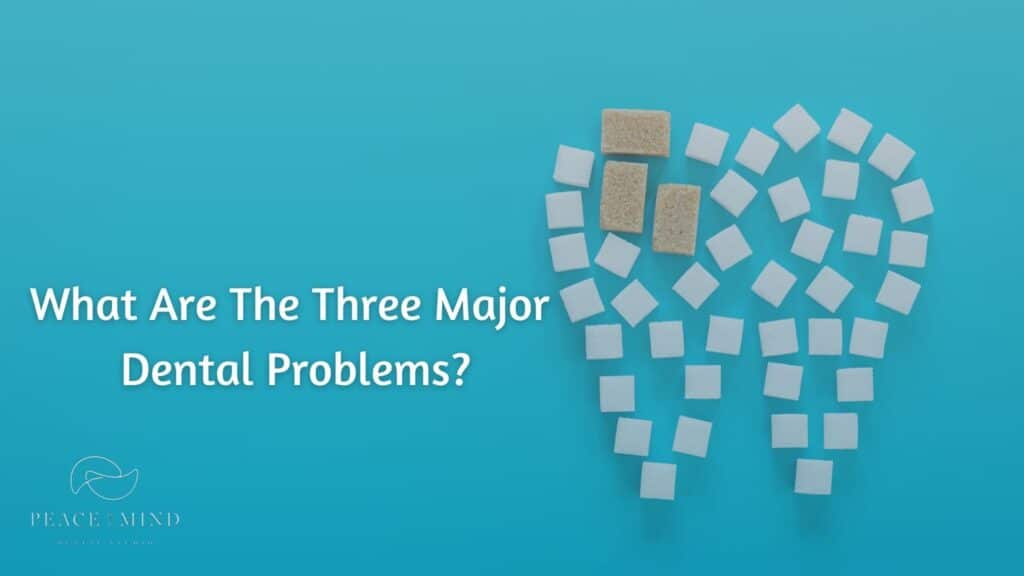
Maintaining oral health is a personal responsibility. You must brush your teeth, floss them, use mouthwash, and get regular dental checkups.
As per a survey, 35.83% of the US population has never visited a dentist.
As a result, several dental problems arise, including cavities, tooth decay, teeth staining, etc.
However, three major problems stand out which require quick dental treatment.
In this blog, you will learn about the three major dental problems. We will also discuss the required treatments at Peace of Mind Dental Studio.
Cavities
Here is a scary fact.
Do you know that 90% of the US population aged 20-64 have experienced tooth decay at least once in their lives?
Almost 21% of these people have untreated cavities.
The reason behind cavities is ignorance of healthy oral practices and not making the right lifestyle choices.
Consuming acidic and sugary foods and drinks, smoking, alcohol consumption, not brushing teeth twice a day, etc., are some of the reasons that cause cavities. Over time, the enamel wears off, and bacteria attack the dentin layer. They create very small, invisible holes in teeth. It leads to visible holes and pits in the teeth, which, if untreated, may progress to severe pain or infection.
Symptoms
The symptoms of cavities are as follows:
- Sensitivity in teeth.
- Toothache.
- Dark spots on teeth.
- Holes in teeth.
- Pain when chewing or drinking.
Cavity Treatments
Based on the extent of cavities, different treatments are prescribed.
Fluoride Treatment: When the problem is sensitivity and there are no holes in the teeth, fluoride treatment is prescribed to fix the tooth enamel.
Fillings: If there are small holes in teeth, they are cleaned and sanitized. The holes are filled with composite resin or amalgam.
Root Canal Therapy: A root canal is required if the cavities reach the tooth pulp. In this process, the infected part of the tooth is removed and filled with gutta-percha. It is sealed with a sealant or crown.
Crowns: A dental crown is installed when the tooth’s integrity is affected. It is specially designed to fit the gap and match the rest of your teeth.
Gum Disease
Periodontitis, or gum disease, is one of the major dental problems. Its repercussions make it a dangerous medical condition. It starts with gum inflammation (gingivitis). In gingivitis, the gums get inflamed due to the plaque and tartar buildup. Do you see a hard yellow layer at the base of your teeth, lining the gums? It pushes the gums away and causes inflammation.
If left untreated, it leads to periodontitis, where the gums start pulling away from teeth. It also leads to bone loss. Poor oral hygiene is the leading cause, but smoking and certain medical conditions can increase the risk.
Symptoms
The symptoms of gum disease are as follows:
- Receding gums.
- Persistent bad breath.
- Swollen and red gums.
Gum Disease Treatments
Here are the different gum disease treatments:
Scaling and Root Planing: Regular brushing is enough to maintain oral hygiene. However, if the plaque and tartar create a hard layer, it is hard to remove on your own. You require scaling and root planing. In this process, the plaque and tartar are removed so the gum can recover.
Antibiotics: When the infection is severe and you are in much pain, antibiotics are prescribed.
Surgery: In severe situations, flap surgery to clean deep pockets or bone grafting to restore lost bone is required.
Tooth Loss
There are many reasons behind tooth loss. If you had an accident and the injury knocked your tooth out, the tooth might never recover. Severe gum disease, cavities, trauma, or other medical conditions also cause tooth loss.
Missing teeth affect teeth’ functionality and appearance and rob your confidence and self-esteem.
Symptoms
The symptoms of a potential tooth are quite evident:
- Toothache when chewing.
- Changes in facial structure due to bone loss.
- Difficulty speaking due to missing teeth.
Tooth Loss Treatments
Dentures: Dentures can be partial or full, which fit into the missing gaps and offer functionality & aesthetic benefits.
Bridges: Dental bridges can be helpful when you have more than a few teeth missing in your mouth. They have crowns on both sides which fit on the adjacent teeth and the pontic replaces the missing gaps.
Dental Implants: Dental implants are beneficial when a tooth root is missing. The dental implants have a titanium root, which fits into the missing root’s place. In a few months, the gums should adopt the root. Afterward, an abutment is placed, and a crown is installed.
Conclusion
When discussing oral issues, these three dental problems are always mentioned. You shouldn’t be worried because every dental problem can be treated. All you need to do is maintain a proper dental routine. Getting your teeth checked periodically is also important to detect potential issues before time. If you are experiencing any symptoms, it’s time to consult us at Peace of Mind Dental Studio, Chandler.


